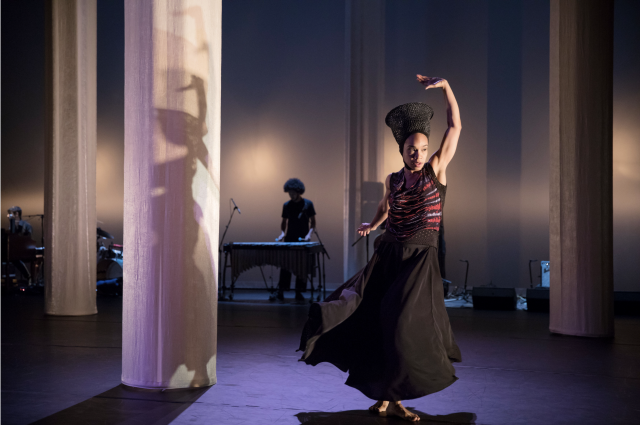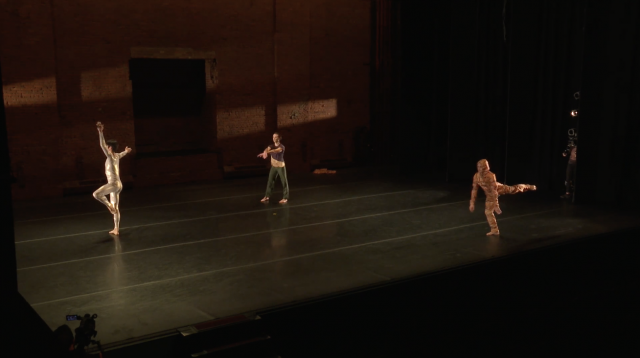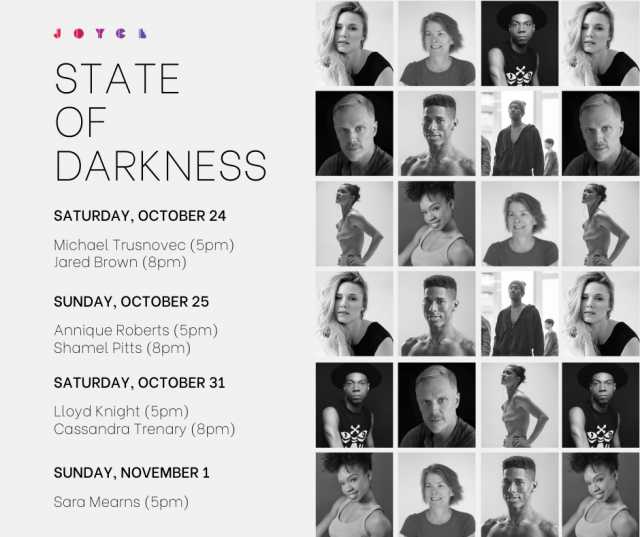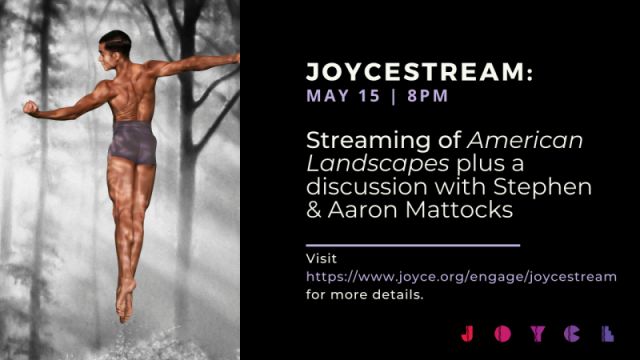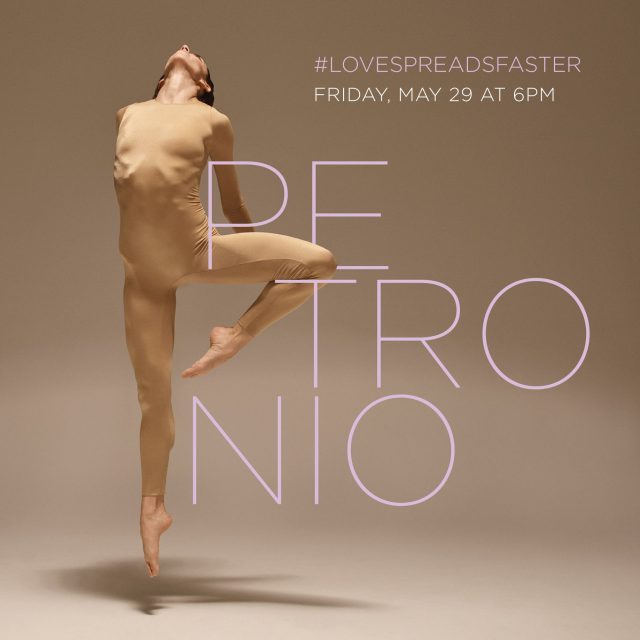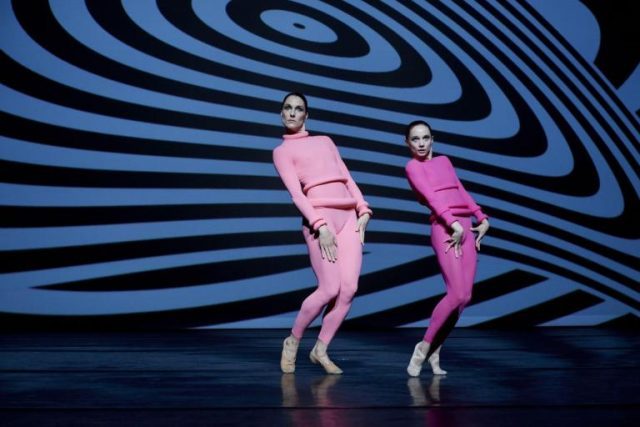
PTDC artistic director Michael Novak is deep in thought during rehearsal for Joyce season (photo by Whitney Browne)
PAUL TAYLOR DANCE COMPANY
Joyce Theater
175 Eighth Ave. at 19th St.
June 14-19, $71-$91 (Curtain Chat follows June 15 show)
212-645-2904
www.joyce.org
paultaylordance.org
Growing up in a Chicago suburb, Michael Novak initially tried his hand at sports, but when that didn’t go very well he soon found his muse in musical theater and dance, as both a performer and a disciplined student. Dance became a form of expression that helped him through a severe speech impediment when he was twelve.
He was an artistic associate at the Columbia Ballet Collaborative at Columbia University, where he performed Paul Taylor’s solo from Aureole and graduated magna cum laude and Phi Beta Kappa in 2008. He made his debut with Paul Taylor Dance Company in 2010-11 — Taylor created thirteen roles on him — and, on July 1, 2018, was named the artistic director designate.
At the time, Taylor announced, “I know that Michael is the right person to lead my company in the future. I look forward to working with him to continue my vision.” However, Taylor died that August at the age of eighty-eight, leaving Novak to take on his mentor’s legacy.
Having guided PTDC through a two-year pandemic lockdown, Novak is now ready to present three special programs at the Joyce, running June 14-19, offering something different from the company’s usual seasons at City Center. The schedule consists of Taylor’s Events II (1957), Images and Reflections (excerpt; 1958), Fibers (1960), Aureole (1962), Tracer (1962), and Profiles (1979), along with a pair of PTDC commissions: the world premiere of Michelle Manzanales’s Hope Is the Thing with Feathers and the New York premiere of Peter Chu’s A Call for Softer Landings.
On the eve of opening night, Novak, who is married to award-winning Broadway choreographer Josh Prince, shared his thoughts on transitioning from dancer to artistic director, navigating through the coronavirus crisis, and planning the future of a beloved, legendary troupe.
twi-ny: You performed with Paul Taylor Dance Company for nine years and were named artistic director designate only a few months before Mr. Taylor’s passing. What were the initial challenges of maintaining his legacy, especially with him no longer there?
michael novak: One of my goals as artistic director is to both preserve Mr. Taylor’s art, legacy, and values while also innovating to push the art form forward driven by my own beliefs and vision. Initially, many of the challenges were centered on how to hold space for the death of a founder and simultaneously move forward, bringing tens upon tens of thousands of people along with us.
But we did it, launching the Celebration Tour in 2019 — a multiyear international retrospective of the most celebrated and captivating dances by Paul Taylor — and creating PTDF Digital, a platform that created a host of unique digital engagements during the pandemic.
twi-ny: How was your transition from dancer to artistic director?
mn: The transition from dancer to artistic director was, overall, smooth. I have always had a passion for arts administration, dance history, and graphic design, so those passions have served me well, as has my education from the Columbia University School of General Studies.
twi-ny: Just as you’re establishing yourself as artistic director, the pandemic hits. What was lockdown like for you, both personally and professionally?
mn: The initial phase of lockdown was extraordinarily unsettling because I was very concerned about our dancers’ safety and company’s sustainability. Simply, we worked nonstop . . . on revamping our educational platforms, rethinking social media strategy, building new ways to engage with patrons and audiences, and, most importantly, getting our dancers back in the studio as soon as possible. We knew that if we wanted to thrive in such a volatile environment, adaptability and sustained momentum were essential.
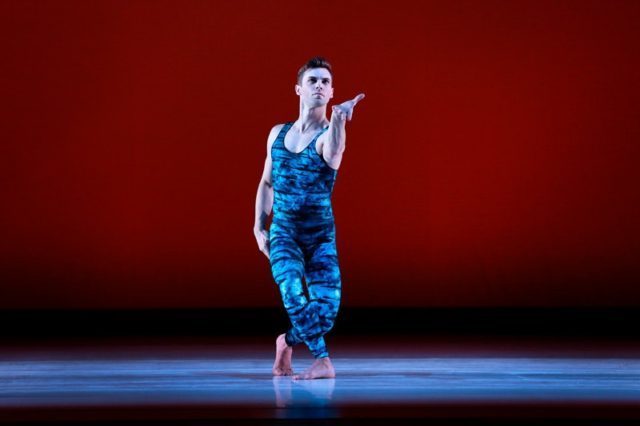
Michael Novak performs in Paul Taylor’s Concertiana (photo by Paul B. Goode)
twi-ny: In some ways, dance thrived during the coronavirus crisis, unlike other art forms, leading to innovation in online productions. PTDF Digital included the 2021 gala benefit “Modern Is Now: Illumination.” Can you describe that title and what it has been like creating digital works?
mn: I believe modern is a movement, not just a moment. So, “Modern Is Now” is another way of creating an awareness of our present moment to create and experience something new. Being modern has been the foundation of our past and it is what propels us into the future. It has been a very thrilling opportunity to step into the digital world and reach audiences in new ways. At the same time, it has made me realize the poignancy and preciousness of live performances where audiences and artists are in the same space experiencing art together.
twi-ny: In March, PTDC returned to the stage and live audiences at the City Center Dance Festival. What was that experience like?
mn: It was wonderful to be back on the New York stage for our audiences, and at City Center, where so much of our history was made. It was emotional on both sides of the curtain.
twi-ny: The City Center shows saw Michael Apuzzo’s final bow as a dancer, and Jessica Ferretti and Austin Kelly have joined the troupe. What does it take to be a Paul Taylor dancer?
mn: Taylor dancers are known for their athleticism, power, transcendence, and, most importantly, their individuality. They are also known for their emotional range — from the comedic to the horrific, and everything in between.
twi-ny: In preparing for the Joyce season, what Covid-19 protocols were in place, and how did that impact rehearsals?
mn: Covid protocols have changed constantly over the past two years. Our board of directors has been relentless in supporting the company at every stage of this recovery, from daily testing, mask wearing, building upgrades, rehearsal schedule adjustments, etc.
twi-ny: The Joyce season includes the sixtieth anniversary of Aureole, which was a major turning point in Taylor’s career as he reexamined dance as an art form. How do you approach such a piece in 2022? You yourself danced the solo when you were studying at Columbia.
mn: This lyrical, joyful work was a controversial departure from the norm of modern dance in 1962, and it catapulted the then-thirty-two-year-old choreographer to the forefront of the dance world — a position he never relinquished. This is a seminal work that is as impactful now as it was on its premiere. We work diligently with alumni to ensure that its poignancy remains steadfast while also encouraging each artist to find their own voice within the work. It’s balancing both preservation and interpretation.
twi-ny: The three Joyce programs include major works from more than fifty years ago, a New York premiere by Peter Chu, and a world premiere by Michelle Manzanales. What was the impetus behind these specific selections, and how do they differ from the company’s usual Lincoln Center shows?
mn: As artistic director my goal is to curate theatrical experiences that celebrate both our ever-expanding dance repertory and the unique venues we perform in. I have been interested in presenting a series of performances that link early, foundational works from the Taylor canon with new works for a very long time. I am thrilled to present premieres by two of today’s most captivating choreographers, Peter Chu and Michelle Manzanales, at the Joyce.
My vision is to juxtapose the past and future of our company in one of the most intimate dance theaters in our city so audiences will understand — more than ever — how our company sits at a fascinating intersection of radicalism and beauty. These early dances by Paul Taylor were made on small ensembles, and audiences will benefit greatly from their proximity to the stage. It will be up close, visceral, and vibrant.
twi-ny: Four years after taking over as artistic director, what do you see as the next chapters for the company?
mn: The Paul Taylor Dance Company is one of the most innovative, athletic, and expressive dance companies in the world. Our next chapter takes us into celebrating seventy years of bringing the best of modern dance to the broadest possible audience.
We will continue to bring Paul Taylor’s great dances to stages around the world; curate great modern dance from the twentieth and twenty-first centuries; invest heavily in the creation of new work by our resident choreographer, Lauren Lovette, and other compelling choreographers and designers; and expand our educational programming and outreach initiatives.
Modern dance is born out of a desire to innovate, rebel against convention, liberate the human body, and to express the freedom of the emotions of the soul. The need for this never subsides, and our company will never stop innovating and responding to our experiences in the world.
